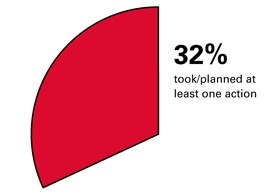
About one out of three readers (32%) reported that they took or planned to take at least one action after seeing a 1-page, 4-color ad in 2011. Furthermore, readers were asked which actions they took after seeing an ad.
About one out of three readers (32%) reported that they took or planned to take at least one action after seeing a 1-page, 4-color ad in 2011.
Our Message Impact® survey asks about actions taken after seeing an ad. Multiple answers were accepted, and they breakout as follows.
Data taken from 1,695 1-page, 4-color ads measured in 2011 Readex Message Impact® studies. Respondents were asked “What actions did/will you take after seeing this ad?” Response options included: Visit advertiser’s website, file for reference, discuss ad with others, contact advertiser, dealer or rep., recommend product/service, purchase product/service, no action, currently own or use, and no action taken. Some questionnaires included the response option, returned reader service card.
Driving Traffic
On average, after seeing an ad, 13% of all respondents visited or planned to visit the advertiser’s website. As a result, print ads do no worse in driving website traffic than banner ads, in fact, these results show that print ads may even drive more traffic. Seems counter-intuitive, right? But depending on where you look, average click-through rates of banner ads hover around 1% or so. With 13% of readers stating that they visited or planned to visit the website after seeing the ad, there’s great potential for generating website traffic.
Even better than the additional traffic is that the group of readers that arrive via print ad are more engaged than the online clicker. Think about it. When visiting from a print ad, readers have to switch formats to visit the site: either they belly up to their computer and type in a URL, click on a QR code, or do a search to find more information. It requires much more effort for people to visit a website from a print ad, suggesting a higher level of engagement than someone who simply clicks an ad.
By driving traffic to the websites, print ads accomplish the difficult task of getting readers to act. Advertisers can get more out of this added traffic by using a special landing page that features a simple URL that dives deeper into the print ad’s sales story. Opportunities may be lost if information is too difficult to find.
Driving Sales
When asked, 6% of readers responded that they purchased or planned to buy a product as a result of seeing a 1-page, 4-color ad, indicating that print ads can prompt purchase.
Other Actions Bring Benefits As Well
Think about the other actions listed as a reminder that readers can be at various points of the buying cycle. Filing for reference (13%) could mean that the product will come up during the next round of budgets. Discussing with others (8%) may mean that it was shared with a group of people at a staff meeting. Recommending the product (4%) means the advertiser has achieved word of mouth exposure. Finally, besides purchasing a product or service, contacting the advertiser, dealer, or rep (3%) illustrates the highest level of engagement on the reader’s part and gets the potential client onto the advertiser’s radar, so the prospect can be nurtured into a client.




